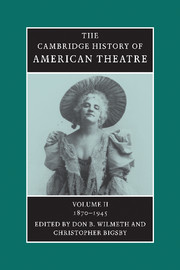Book contents
- Frontmatter
- Introduction
- Timeline: Post-Civil War to 1945
- 1 The Hieroglyphic Stage: American Theatre and Society, Post-Civil War to 1945
- 2 A Changing Theatre: New York and Beyond
- 3 Plays and Playwrights
- 4 Theatre Groups and Their Playwrights
- 5 Popular Entertainment
- 6 Musical Theatre
- 7 Actors and Acting
- 8 Scenography, Stagecraft, and Architecture
- 9 Directors and Direction
- Bibliography
- Index
Introduction
Published online by Cambridge University Press: 28 March 2008
- Frontmatter
- Introduction
- Timeline: Post-Civil War to 1945
- 1 The Hieroglyphic Stage: American Theatre and Society, Post-Civil War to 1945
- 2 A Changing Theatre: New York and Beyond
- 3 Plays and Playwrights
- 4 Theatre Groups and Their Playwrights
- 5 Popular Entertainment
- 6 Musical Theatre
- 7 Actors and Acting
- 8 Scenography, Stagecraft, and Architecture
- 9 Directors and Direction
- Bibliography
- Index
Summary
For theatre historian Arthur Hornblow, writing in 1919, American drama had virtually ceased to exist by 1870. In its place, he insisted, had come foreign imports, a characteristic lament of American critics from the eighteenth to the twenty-first century. Nor, according to Henry James, did the theatre have a direct and organic relationship to American society in the way that, for example, the novel did. It was the source of distraction, entertainment, and amusement but not of a cogent engagement with the values and experiences of a nation in other respects so concerned with its own exceptionalism. Writing in 1875, he remarked that:
If one held the belief that there is a very intimate relation between the stage, as it stands in this country, and the general cause of American civilization, it would be more than our privilege, it would be our duty … to keep an attentive eye upon the theatres. … But except at the Fifth Avenue Theatre, [the public] does not go with the expectation of seeing the mirror held up to nature as it knows nature – of seeing a reflection of its actual, local, immediate physiognomy. The mirror, as the theatres show it, has the image already stamped upon it – an Irish image, a French image, an English image …!
(Quoted in Moses and Brown, 122)- Type
- Chapter
- Information
- The Cambridge History of American Theatre , pp. 1 - 23Publisher: Cambridge University PressPrint publication year: 1999
- 1
- Cited by



